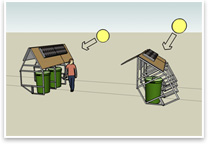 Between Home and Hospital Between Home and Hospital
Chicago’s Lawrence Hall builds a residential treatment building that culminates 140 years of child welfare design.
The Residential Treatment Center at Lawrence Hall in Chicago provides the safety and security appropriate for a child welfare agency that treats at-risk children while still offering a warm and reassuring community-based experience. Its design, as well as previous Lawrence Hall residential buildings, has adapted prevailing urbanism models to this particular youth treatment setting. It is the first part of a three-phase renovation of the entire campus, all by local architecture firm McBride Kelley Baurer. 
 Condo Sell: A Model Bachelor Pad for Swinging Singles Condo Sell: A Model Bachelor Pad for Swinging Singles
Luxe model apartment designed by GKV Architects targets men’s contemporary living
New York-based GKV Architects recently celebrated the grand opening of its “swinging bachelor pad” model apartment at Sky House Condominiums, a 55-story brick-and-glass luxury residence in downtown Manhattan. The Sky House Condominiums, designed by Bruce Fowle, FAIA, senior partner at New York-based FXFOWLE Architects, targets New York’s jet-set single male demographic. The 1,800-square-foot model apartment by GKV Architects offers a luxury interior design of plush finishes and amenities from bygone “swinging” eras combined with today’s industrial chic styles and today’s technology. The concept behind the bachelor model apartment is to demonstrate to potential Sky House buyers, chiefly single males, how they could decorate their own space. There are 139 one-, two-, and three-bedroom apartments in Sky House, with no more than three per floor, all with skyline views in each direction. GKV Architects partnered with New York-based developer Clarett Group, the Sky House Condominums developer, on the model apartment design project. 
 A Mile Is Worth a Penny A Mile Is Worth a Penny
Boston-based One Penny Per Mile seeks to raise funds by reducing our carbon footprint
One year ago, Boston architect Paul Brown, AIA, LEED-AP, started a new non-profit organization called One Penny Per Mile, based on the concept that automobile drivers who want to reduce their carbon footprint or, as Brown says, “offset their carbon usage in a meaningful way,” contribute a penny to One Penny Per Mile for every mile they drive. One Penny Per Mile, in turn, will use the money to design, construct, and install renewable energy systems, such as photovoltaics, at local public locations that will include schools. One Penny Per Mile has been incorporated, achieved 5013c status, conducted an initial round of fundraising, established a board of directors, and is currently installing its first renewable energy system at The Walker Home and School in Needham, Mass. 
|
 Between Home and Hospital
Between Home and Hospital 
 Condo Sell: A Model Bachelor Pad for Swinging Singles
Condo Sell: A Model Bachelor Pad for Swinging Singles  A Mile Is Worth a Penny
A Mile Is Worth a Penny